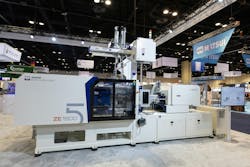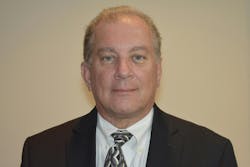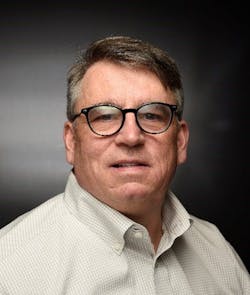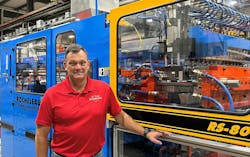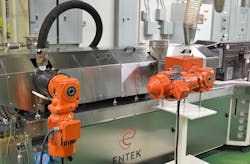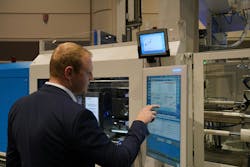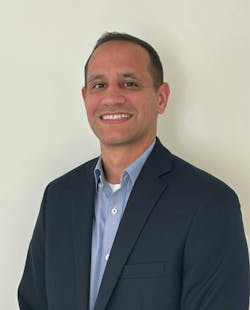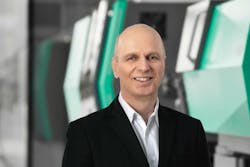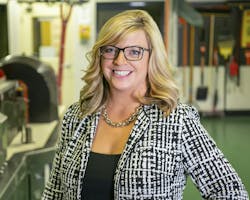Will the plastics machinery market rebound in 2025?
By Lynne Sherwin, Karen Hanna and Bruce Geiselman
Since Plastics Machinery & Manufacturing conducted its first survey in fall 2019, asking processors about their machinery investment plans for the upcoming year, the industry and the world have been buffeted by shock after shock — the pandemic, broken supply chains, a shortage of skilled workers.
Those problems began to recede in last year’s survey, superseded by a new worry: that the resurgent economy would crash into a recession.
By the time our 2024 survey was conducted in October, those fears had not come to pass, but the Federal Reserve System’s inflation remedy — high interest rates — had left a sour taste for many processors and OEMs, dampening hopes of a sales bump in the wake of NPE’s return after six years. The economy remains a top concern.
The number of processors who expect business to be better in 2025 rose slightly over the previous year, to 58 percent from 56 percent. Those who expect it to remain about the same also rose 2 percentage points, to 33 percent from 31 percent.
Sixty-six percent of respondents plan to purchase primary processing equipment in 2025, with 39 percent expanding capacity and 29 percent replacing existing equipment. Most plan to spend less than $1 million (60 percent) while 5 percent expect to spend more than $10 million.
Perc Pineda, chief economist for the Plastics Industry Association, said the survey’s results align with his expectations for 2025, and the fact that two-thirds of respondents plan to buy primary equipment is a good sign.
“It really reflects the optimism of processors and the industry as a whole. It reflects expectations that risks may be lower in 2025 compared to 2024, or at least moving in that direction, considering that we have seen interest rate cuts recently,” he said. “And the expectations of further interest rate cuts in 2025, I think, is also baked into the responses.”
He noted as a positive sign that 39 percent of those investing in primary equipment are doing so to expand capacity, as many companies that grew rapidly during the pandemic had struggled to fill that capacity over the past two years.
Only 17 percent of respondents said they plan to spend less on equipment in 2025 than in 2024; 40 percent plan to invest more; and 43 percent will spend about the same amount, which Pineda called “very, very strong,” indicating that economic conditions and interest rates had affected business decisions in 2024.
Although the survey was conducted prior to the U.S. presidential election, Pineda said the optimism seems to indicate that “whatever the outcome of the election was, would result into a better policy mix to get the economy going. Not that it hasn't been growing, but we have been suffering with an interest rate-driven manufacturing slump in the last couple of years.”
The survey asked about several issues processors are facing, and how these issues have affected their business. The state of the economy and interest rates drew negative marks from the highest number — 64 percent of respondents, up 6 percent from the previous year. About 39 percent expected to spend less on equipment in 2025 because of those concerns.
The labor shortage remains a worry for nearly half of respondents — 49 percent, down from 54 percent the previous year. Other issues negatively affecting a significant number of processors were supply chain challenges (43 percent) and resin shortages and price hikes (40 percent).
Respondents commented on the cost of skilled labor and the knowledge gap, their customers’ economic worries and slowing automotive sales.
“Although we see a brighter future for the USA in 2025 and beyond, our business is still subject to attracting and retaining labor. In addition, the supply chain is still shaky as the geopolitical unrest in China/Taiwan and the Middle East are causes for concern,” said Paul Harencak, VP of LPS Industries, a vertically integrated flexible packaging manufacturer in New Jersey.
Regarding the labor shortage, Harencak noted that modern manufacturing is "not the dirty smokestack factories of the past,” and now relies on educated workers who need to be encouraged.
“This need must start with educating the faculties and the students, starting in the middle and high schools. Manufacturing jobs pay high wages, generous benefits, and studies have shown that for every manufacturing job, there are four additional service jobs to support manufacturing,” he said.
LPS Industries has invested heavily in production equipment, computer hardware and software upgrades over the past several years, Harencak said, and does not plan to make major equipment purchases in 2025.
American Plastic Molding (APM), a Scottsburg, Ind., custom molding shop, recently acquired a 900-ton Milacron press and a Phrozen 3D printer.
Adam Auffart, the company’s VP of sales and marketing, expects business to improve next year.
“Many new projects that were launched in 2024 will start realizing revenue in 2025, and I also think reshoring will continue to help APM,” he said, although the company is watching for a potential impact of tariffs.
In 2025, “we do plan the replacement of two molding machines and robots, but we are also working on several projects that would require auxiliary equipment and if we land them, we are more than ready to invest,” he said.
A smaller percentage of processors who responded to the survey plan to purchase auxiliary equipment in 2025 — 56 percent, compared with 68 percent last year. Reasons for planned purchases were split evenly between replacement of existing equipment and expansion of capacity.
However, Pineda said that’s still a strong number, and since auxiliary equipment is “subject to more wear and tear,” replacement efforts could drive growth in sales. Two processors who responded to the survey cited energy efficiency and environmental concerns as reasons for upgrading their auxiliary equipment.
Just over half of respondents, 55 percent, offer injection molding, while 31 percent engage in mold or tool making and repair. Other processes employed by respondents include recycling (19 percent); compounding (18 percent); pipe, profile or tube extrusion (16 percent); additive manufacturing (14 percent); film or sheet extrusion (13 percent); thermoforming (12 percent); blow molding (11 percent); and rotomolding (4 percent).
Respondents could choose more than one process.
OEMs look into the future
Equipment makers are divided on their prospects for the year ahead.
Glenn Frohring, co-owner of Absolute Haitian, took heart from recent improvements in several consumer confidence indices from the Conference Board think tank.
“Up until the fourth quarter, we felt a sense of caution among many of our customers,” he said. “We believe the consumer confidence numbers, lower interest rates and the presidential election being over will encourage molders to invest in equipment in 2025.”
However, he said he predicts flat sales in the new year.
"The inventory of secondhand machines is high. But inventories for molded parts have been reduced so there will need to be machine purchases made at a conservative level,” he said.
Sonny Morneault, president of Wittmann USA, sounded an optimistic note.
“Our outlook for 2025 is very positive. With such a diverse product line, when one is down, others are up,” he said, noting the company’s robot and automation business unit is gaining market share.
While auxiliary equipment like temperature controllers, dryers, blenders and loaders saw a dip in 2024, he expects a strong return in 2025, along with opportunities in materials- handling systems.
“I see a rebound. We have seen an increase of productivity, especially in the third quarter and the fourth quarter of the calendar year,” said Vanessa Malena, president of Engel Americas. “I don't think it's going to be a huge jump fast, but I think we're going to see a rebound. And I think it'll be a more manageable growth instead of just a huge spike.”
She said Engel has increased its market share, even as the overall market has slowed and more competitors have entered the business.
Martin Baumann, managing director of Arburg Inc., said he expects modest growth in 2025, following the trend from the third and fourth quarters of 2024.
“Molders are still bringing existing machines, which were sidelined during the pandemic, back online. High interest rates have also slowed new investment,” he said. He’s also concerned about the effect of potential tariffs.
Sumitomo (SHI) Demag also anticipates a slow recovery, but more toward the end of 2025, said CSO Anatol Sattel.
Nadeem Amin, president of Netstal Americas, said he was cautiously optimistic on the PMM Insight podcast in November.
“People are still investing, but they're really putting a lot of thought into the investment. I think overall, from what I'm seeing, it will be a better year. I think 2025 and 2026 are going to continue to get better," he said.
Steven Rocheleau, president of Rocheleau Tool & Die, expressed confidence in the market for his company’s blow molding machinery.
“Backlog heading into 2025 is at the highest level in years, and so far, the new level of business appears to have traction. However, there is still some caution regarding interest rates, ability to find labor to support new installations, potential tariff implications and global instability,” he said.
He also observed that as companies relocate to other parts of the country, rather than moving older machines, they are choosing to start fresh with more advanced and efficient equipment.
“Our business outlook is positive, and we are hiring in numerous key facets of our business, especially for our U.S. manufacturing team,” said Gary Carr, VP of sales for Bekum America.
He said he anticipates growth in demand for packaging machinery, especially for handling recycled plastics, and that customers are looking for machinery that is flexible and changeover-friendly.
But Brett Greenhalgh, acting president and CFO at KraussMaffei, sounded downbeat about the new year.
“2025 is going to be a tough year. There's no doubt about it. The industry is hard right now. A lot of our traditional customers are not investing like they have in the past,” he said. But he’s still forecasting some growth, “and we're striving to capitalize best we can in a very difficult market.”
Peter Zut, KraussMaffei’s VP of sales and service – extrusion, said he sees traction in growing sectors like recycling, PVC and polyamide for hydrogen pipe applications that need specialized expertise and production lines.
Meanwhile, Charlie Martin, president of extruder maker Leistritz, called himself “cautiously optimistic due to a late-year surge in orders.”
“There is no doubt we see business owners concerned as to what this economy will do in the next few months,” said Linda Campbell, VP of sales for extruder maker Entek. “With the recent election past us, we feel this helps give some insight into business and consumer confidence. If we can see interest rates continue to decline, we expect to see a much stronger 2025 than 2024. “
Interest rates flatten ‘NPE bump’
Pineda pointed out that interest rates don’t just affect processors and their equipment investments; their customers also must make decisions based on borrowing costs.
“Even if they [processors] can finance equipment, their customers who would be funding all these projects that they would be getting contracts on are probably risk-averse because of the high interest rates,” he said, so processors will wait to invest in equipment until their customers feel more confident.
Many OEMs reported little to no sales bump after NPE in May, which Pineda said was not surprising.
“There was so much optimism on the show floor, but at the same time, economic fundamentals were actually holding back people from pulling the trigger,” he said.
Frohring said Haitian saw a jump in sales in the third quarter of 2024 that the company attributes at least in part to the show.
“Some molders hold back their machine purchase plans to see if their decisions are impacted by what they find at NPE. We met with a lot of customers and that in-person handshake also seems to translate into a machine order. The big surprise to us was uncovering leads on new business with molders we haven’t done business with before,” he said.
Rocheleau said prospects from the show are turning into active projects for 2025.
“NPE was a great event for us, as we were able to present a new application on our Model RS-90 reciprocating screw blow molder for larger-size containers, including off-center neck production. Blow molding is a niche market, so NPE is a great way for us to make an impression on our customers and prospects to keep us in mind when projects become active,” he said.
Tammy Straw, director of Entek’s wear parts division, was pleased: “We were able to display the technology we’ve been working to develop, as well as showcase our replacement parts and material-handling divisions. We have seen an uptick in business as a result and earning new customers.”
Others said while sales haven’t yet materialized, they considered the show a success for visibility and customer interaction.
“Anytime you gather 50K-plus industry colleagues there is always a buzz created,” said Morneault, citing interest in Wittmann’s R9 robot control system, turnkey solutions and smart features.
“We look at shows like NPE as an opportunity to share knowledge – not just push our machines. That said, we booked a number of mold trials after the show that have resulted in sales,” said Len Hampton, national sales manager for Plustech, which makes Sodick injection molding machines.
Kohei Shinohara, senior VP of Plustech, pointed out that the company generated additional customer interest with an NPE preview event at its Elk Grove Village, Ill., headquarters, with demonstrations of Sodick machines running difficult materials and complex parts.
Carr said Bekum was happy with the show, with both established customers and new prospects visiting the booth.
“We have certainly seen an uptick in quote activity; hard to say if interest rates are a significant driver,” he said.
Sumitomo (SHI) Demag reported no direct boost after the show, but feedback was positive on the company’s integrated and turnkey systems, as well as digital solutions and services, Sattel said.
“We don’t believe a show, even a big one like NPE, can turn the fundamentals of the economy around,” said Arburg’s Baumann, but those face-to-face interactions are still “hugely important” for when customers are ready to consider new investments.
Sven Skowronek, KraussMaffei’s VP of sales and project management – IMM and automation, said the company considered the show a “huge success globally,” showing off all four of its divisions (injection molding, extrusion, reaction process machinery and additive manufacturing) and its sustainable capabilities.
Automation, smart functions have room to grow
While OEMs showed off smart technology, artificial intelligence (AI) and advanced automation at NPE, many processors are still slow to integrate the features.
“We haven’t seen a big increase in sales from NPE this year as many had anticipated. That might have more to do with the current state of the overall market than anything from the show itself,” said Anthony Zambanini, director of sales and marketing for Sepro North America.
The percentage of survey respondents planning to invest in automation ticked back up to 47 percent, from 41 percent in last year’s survey. About 40 percent plan to spend less than $20,000, while 19 percent plan to spend more than $100,000.
“Overall, the market is still slow, especially when comparing to the post-Covid boom. We are still seeing more quoting activity in some regions, which is always a good sign, even if it’s just in a few areas for now,” Zambanini said.
He added that when new business is down, Sepro sees customers focusing on maintenance and training on existing equipment. He believes this year will start off slow, but “the U.S. market is strong and resilient, and we continue to stay busy. We’re ready to catch the upswings.”
KraussMaffei offers a variety of robots and automation solutions for functions such as leak testing, labeling, parts feeding, conveying and more, Skowronek said. But many processors are still reluctant to jump in.
“There’s a need for automation in the industry, but it can be daunting if you’ve never had to use a robot interfaced with a machine before. We are offering automation to companies that never considered it before, and we’re cognizant we have to help them through this learning curve,” he said.
“Automation continues to grow in importance, but this can mean different things to different customers,” Rocheleau said.
Because many of his company’s projects are full production cells with materials and bottle handling, automation and inspection — some manufactured in-house, others from outside vendors — Rocheleau has added engineering staff to focus on automation and product line development.
Leistritz’s extrusion customers are also looking for complete lines, Martin said: “Perhaps because of less in-house engineering, customers are looking for machine suppliers to package the system [and] integrate sub-systems via distributive processing.”
Frohring said Absolute Haitian supports integration of automation in two ways: via interfaces on its injection molding machines that connect to a variety of auxiliaries and monitoring systems, and through its sister company, Absolute Robot, which offers “sophisticated, dedicated automation.”
“Automation is important. Customers realize they cannot be left behind and remain competitive. We have seen companies go out of business because they didn’t choose to invest in automation/robots,” he said.
While machinery manufacturers continue to add smart functions and AI, customers are curious, but not always embracing them wholeheartedly.
“We are still seeing a big push to automate but honestly, even though clients want to know about them, things like sustainability, energy efficiency and smart functions have not been widely adopted yet. We think the landscape is changing and these features and functions will be a Top 3 priority in the coming years,” Morneault said.
Frohring said molders are asking about intelligent functions, and pointed out how they can help compensate for inexperienced staff.
“Our Generation 5 molding machines incorporate intelligent functions (HT·Xtend is what we call it) to provide easy operation, so no training is required,” he said.
“Anything that can help molders improve efficiency and overcome problems related to the ongoing labor shortage and high labor costs will be of great interest,” Baumann said, citing interest in turnkey cells for specific applications, configured with smart functions, including AI.
He said the industry has been “somewhat slow in embracing the full capabilities of digitalization,” but he believes customers are coming to realize its usefulness in optimizing processes, tracking data and improving part quality.
Arburg has even created a ChatGPT-based assistant, Ask Arburg, as a premium feature of its arburgXworld customer portal. It allows molders to access information and ask questions about machines and processes, and to troubleshoot problems.
Trends and end markets evolving
Among end markets, packaging and medical appear to be the bright spots in 2025, according to OEMs, including KraussMaffei, Haitian, Wittmann and Bekum.
Frohring said Haitian is aiming to take advantage of projected market growth in cosmetics packaging, as well as “laying the groundwork to take advantage of more medical end-market opportunities ... after placing medical IMMs and clean-room-ready machines with select molders in the past few years.”
The packaging market is also interesting for Sodick.
“Although Sodick is typically known for its micro-molding capabilities, we are observing an increase in orders from customers requiring multi-cavity hot-runner tools for applications such as packaging. There is a growing trend for molds that combine large mold sizes with small shot sizes,” Shinohara said.
Baumann said he expects opportunities in the North American electronics market as data centers and chip-building operations expand.
“We have seen numerous customers continue to invest in new equipment and building expansions in preparation for an economic turnaround as inflation begins to slow, and interest rates continue to decrease,” she said.
Sustainability concerns also continue to influence the machinery market, with companies promising efficiency, investing in recycling advances and working with processors to build equipment that can handle biopolymers.
“One of the biggest trends is sustainability and, of course, energy efficiency. Without being energy-efficient, we would not be able to sell our products anymore,” said Sattel, of Sumitomo (SHI) Demag.
However, demand for one symbol of the sustainability movement — the electric vehicle (EV) — has been slowing down, some OEMs indicated.
“Many invested in increased capacity to mold parts and components for EV vehicles, and those orders have not fully materialized. EVs are here to stay, but conversion appears to be slower than predicted,” Baumann said.
Entek’s customers are looking to develop products with biopolymers, Campbell said, and the company is currently working on a large bio-based project.
Martin said Leistritz is seeing interest in bioplastics as well, along with other kinds of specialty extrusion.
Baumann said Arburg, which offers hybrid and electric machines for energy-efficient processing, and helps customers process biomaterials and recycled materials, can even provide buyers “the CO2 footprint of their machines — what it took to build them — so that can be factored into their overall calculations."
But keeping up with the constantly shifting landscape of plastics recycling can be difficult.
“A general sense of confusion seems to resonate with processors wondering what new sustainability policy will impact their business and how to best prepare for that challenge,” said Carr, of Bekum. “The overriding challenge to larger-scale recycling remains the economics of PCR usage. Simply put, recycled materials need to be cost-advantageous over virgin material.”
Baumann said, “In the end, it’s all going to be driven by consumer demand and the large brands that market to them.”
About the Author
Lynne Sherwin
Managing Editor
Managing editor Lynne Sherwin handles day-to-day operations and coordinates production of Plastics Machinery & Manufacturing’s print magazine, website and social media presence, as well as Plastics Recycling and The Journal of Blow Molding. She also writes features, including the annual machinery buying survey. She has more than 30 years of experience in daily and magazine journalism.
Karen Hanna
Senior Staff Reporter
Senior Staff Reporter Karen Hanna covers injection molding, molds and tooling, processors, workforce and other topics, and writes features including In Other Words and Problem Solved for Plastics Machinery & Manufacturing, Plastics Recycling and The Journal of Blow Molding. She has more than 15 years of experience in daily and magazine journalism.
Bruce Geiselman
Senior Staff Reporter Bruce Geiselman covers extrusion, blow molding, additive manufacturing, automation and end markets including automotive and packaging. He also writes features, including In Other Words and Problem Solved, for Plastics Machinery & Manufacturing, Plastics Recycling and The Journal of Blow Molding. He has extensive experience in daily and magazine journalism.
